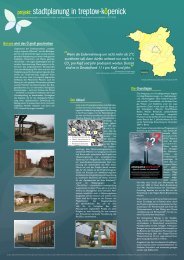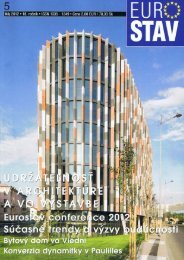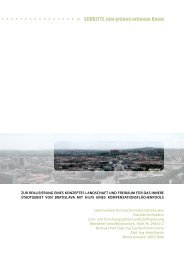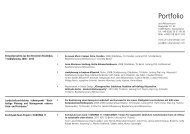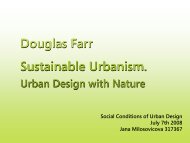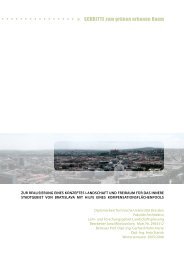Thesis document - Jana Milosovicova - Urban Design English
Thesis document - Jana Milosovicova - Urban Design English
Thesis document - Jana Milosovicova - Urban Design English
- No tags were found...
You also want an ePaper? Increase the reach of your titles
YUMPU automatically turns print PDFs into web optimized ePapers that Google loves.
Appendix 2 City of Toronto’s Study on Green Roof Benefits“Report on the Environmental Benefits and Costs of Green Roof Technology forthe City of Toronto” 1To determine the citywide benefits of green roofs, the study team calculated that approximately 5,000 hectares ofroof area is available for green roofs in the City of Toronto. The study findings, related to UHI effects, to climatechange, and to related costs, were divided into following cetegories:Stormwater runoff3• Reduction in stormwater flow of 12 million m per year (Capital expenditure reductions between 0.6 – 3.4%in stormwater treatment were estimated in case of capturing the rainfall through green roofs) / Infrastructuresavings worth between $2.8 and $79 millionEnergy consumption• Citywide savings from reduced energy for cooling is $21 million, equivalent to 4.15 KWh/m² per year• Cost avoided due to reduced demand at peak times is $68 million<strong>Urban</strong> Heat Island effect• Widespread greening of Toronto’s roof would reduce local ambient temperature from 0.5 to 2°C• Citywide savings from reduced energy for cooling of $12 million, equivalent to 2.37 kWh/m² per year• Cost avoided due to reduced demand at peak times of $80 millionAir quality and emissions• Reduction in levels of CO, NO , O , PM , SO and in CO emissions2 3 10 2 2Building level benefits• Energy savings from better solar reflectivity, evapotranspiration and insulation• Green roofs last up to twice as long as regular roofsA detailed derivation of economic benefits from green roofs was made, in which many factors, individual costs andbenefits were taken into account, such as:• <strong>Urban</strong> heat island: Lowering temperatures by up to 0.8°C thus reducing energy demand in summerby up to 10%.• Energy costs savings: Saving on cooling costs estimated by approx. 15%, by green roof annual energy savings ata value between $2,500 and $12,500. These savings could significantly decrease the installation costs of greenroofs. It however needs to be noted that cooling cost savings due to green roofs in well insulated buildings witharound 2% is negligible (Emmanuel 2005, p. 41).• Discount rate applied to future costs and benefits; a range of 0-2% for climate change was used.• Air pollution and greenhouse gas effects: Significant reductions of airborne particulate matter and other airpollutants (valued at 10 – 30% reductions of particulate matter).• Food production on rooftops: Local food production has an impact on energy use related to the transportation offood and the availability of locally produced fresh food. (It is assumed that the value of food production is $1.07per m².)The Toronto example proves the wide-reaching benefits for the whole city, once the green infrastructure proposalshave been set into motion and implemented on a city-wide scale.1 Banting et al. 2005; Abstract80Climate Sensitive <strong>Urban</strong> <strong>Design</strong> in Moderate Climate Zone: Responding to Future Heat Waves. Case Study Berlin Heidestrasse/Europacity



